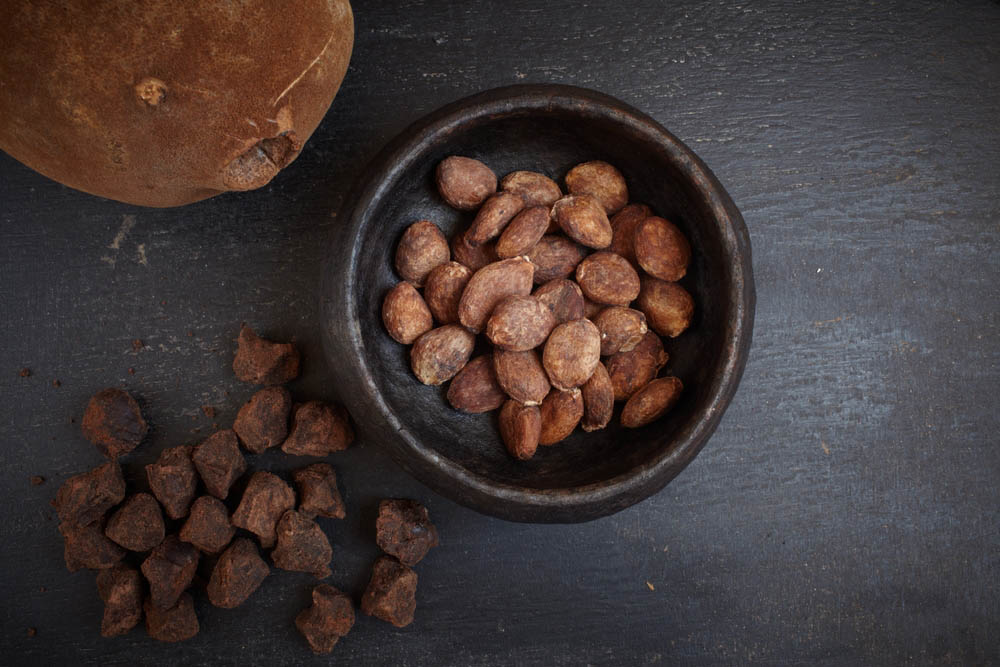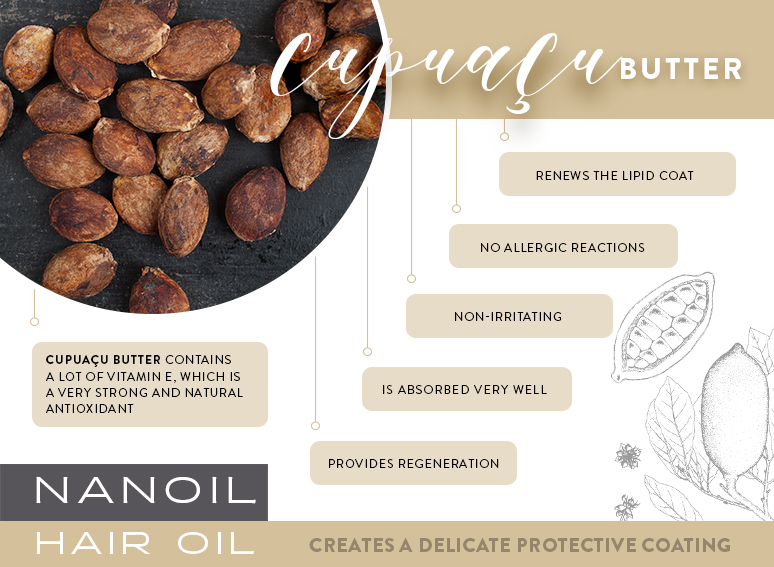- NANOIL Products
- Oils
- Face serums
- Hair masks
- Shampoos
- Hair conditioners
- Hair styling
- Hair Porosity Test
- Blog
- Contact

Cupuaçu butter is obtained from an Amazonian tropical rainforest tree related to cacao. It is one of the most solid vegetable oils. According to the international nomenclature of cosmetic ingredients it is called Theobroma Grandiflorum Seed Butter. What makes it such a valuable cosmetic source? It retains water inside the skin better than lanolin, soothes inflammations, regenerates and is a natural UV filter. Additionally, it has balanced composition of various fatty acids. Would you like to know more?
Most of us love exotic hair oils. The ones that are extracted by cold-pressed form wildly growing plants seem to be richer in natural valuable nutrients. Of course, there is a grain of truth in this sentence. Amazonia is the region that abounds in cocoa trees. One of them is called Theobroma grandifloru and can be seen in eastern Amazonian areas of Brazil. In fact, it contains a lot of valuable therapeutic substances. Cupuaçu butter, cold pressed from the seeds of cacao contains a variety of nutrients as well. This is a close ‘relative’ of better-known cocoa butter.
Theobroma Grandiflorum Seed Butter
There are several oil with names that are very difficult to pronounce. The problem lays in their origins. If you ever ask yourself ‘how to read cupuaçu?’ simply check at the source. The proper way of spelling its name is cupuassu, cupuazú, cupu assu, and copoasu. All other names are incorrect. If you like to be accurate, then do not use them.
Many cosmetologists value this product for the content of phytosterols. What exactly does it mean? Plant sterols are structurally related to sterols, which are part of our intercellular cement. Thanks to it, cupuaçu butter rich phytosterols (beta-sitosterol, stigmasterol, campesterol) effectively strengthens the lipid barrier of the epidermis and hair. Long story short - cupuaçu butter provides protection. But this is not all that can be found in it.
Cupuaçu butter contains a lot of vitamin E, which is a very strong and natural antioxidant. Next, there is a wealth of vitamins C and A - the source of phosphorus and fatty acids. Additionally, cupuaçu butter is also rich in unsaturated omega-9 fatty acids and omega-6, which are balanced with the amount of saturated fatty acids (such as: palmitic and stearic). Therefore cupuaçu butter is perfectly suitable for low porosity hair. Nevertheless, it will work well for strands with medium porosity.
Unrefined cupuaçu butter differs from others because it has solid consistency, even in room temperature. It is a very compact mass. It dissolves after heating to a temperature of 25-37 deg. C. Cupuaçu butter is cold-pressed from the kernel of the fruit of Theobroma Grandiflorum. The hard interior of this fruit has exactly the same colour as oil - bright and milky coffee. Cupuaçu butter has a very delicate scent, sweet and slightly nutty. It does not smell too intensively and, fortunately, leaves no irritating odour on hair or skin.
To begin with, cupuaçu butter is suitable for hair as well as body care. In both cases, it works the same. This product does not cause any allergic reactions, it is non-sensitising and non-irritating. Therefore, it is very often used as a natural replacement for many cosmetics – lotions, creams, conditioners or masks. Cupuaçu butter is absorbed very well, so it does not leave greasy or sticky feeling after application.
Refined cupuaçu butter makes the skin smooth and soft. It is the perfect way to moisturise dry and dehydrated skin. It is especially recommended for people who struggle with atopic, flaking and cracking skin. It provides comprehensive regeneration, as well as protection from harmful effects of sun radiation, toxins, etc. How? The product creates a delicate protective coating. Cupuaçu butter soothes and eliminates redness on the skin and slows down the ageing process as well as ensures cell regeneration. Of course, this also applies to scalp.
It is worth applying cupuaçu butter to hair, since it ensures regeneration and reinforcement. It renews the lipid coat of strands, so that they are better protected and do not lose valuable nutrients. It also maintains proper moisture level. The action of cupuaçu butter is very similar to UV filters – it creates a protective barrier on the surface of your wisps. The substance is also referred to as plant lanolin, because it has high water absorption and prevents evaporation. Hair is permanently moisturised and thereby flexible, soft and shiny. Cupuaçu butter has anti-inflammatory properties so it can prevent follicle inflammation. As a result, it reduces hair damage, inhibits its excessive loss and ensures proper work of hair bulbs.

How to use cupuaçu butter? First of all, be consistent and regular. Only applying it systematically will provide your skin and hair with proper regeneration and the effects will be long-lasting.
What is more, cupuaçu butter provides versatile use. Starting with the fact that it can be applied directly to the scalp and hair and finishing at production of homemade cosmetic. After heating it up, it is suitable to be used for hair oiling treatment (also combined with other oils). Additionally, it will bring stunning effects if used as an addition to masks and conditioners. Moreover, it is often found in ready-made oils such as Nanoil for low porosity hair. No wonder, after all, it provides wonderful effects.
It will be easier to determine it, if we look at the content of fatty acids. Natural and unrefined cupuaçu butter has a lot more polyunsaturated fatty acids which molecules are the largest and best suited for higher porosities. Omega-9 (monounsaturated) and saturated fatty acids are the majority and their number is similar. Therefore, the answer to the question of whether it will work better on low or high porosity hair is very difficult.
Nevertheless, when it comes to high porosity, cupuaçu butter might not work very well due to the fact that it contains very little polyunsaturated fatty acids. Damaged hair can become frizzy, extremely dry, and dull. Because of the concentration of two saturated fatty acids, it should work a lot better on low porosity hair. Therefore, cupuaçu butter is one of the ingredients of Nanoil for low porosity hair. However, since it contains similar amount of omega-9, cupuaçu butter can be used on medium porosity hair as well.
Comments: #0